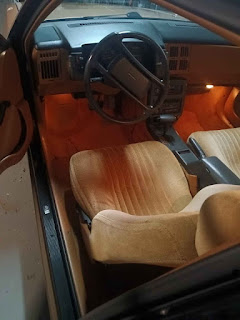What do you get when you cross a panther and a gas crisis? Why, a Mercury Marquis, of course. In this case not just any Marquis but a 1979 Mercury Marquis coupe. You don't see these every day and you didn't see many "back in the day" either.
Years ago, it was the rare sedan that wasn't offered in both four- and two-door guises. Four-door sedans were sold at a premium, you wanted to save a buck or two, you bought a two-door.
With the increase in popularity of four-door sedans, what with their comparative impracticality in relation to them, sales of two-door sedans began to diminish with, at best, their offering little more than a tad more styling elan than the four-door version. In the case of this '79, Mercury marketed its, ahem, sporty roofline to appeal to the fashion conscious. Like many things, what's sporty and what's not is a matter of taste and opinion.
Somewhat ironically, though, in the 1970's, while sales of two-door sedans dropped off, sales of personal luxury cars, which were exclusively two-door models, soared. In retrospect, especially in this day and age of do-everything-well sporty-utilities, it's a bit of a challenge to understand the appeal of personal luxury cars to say nothing of two-door sedans. You either get it, like I do, or you don't.
Although Ford advertised that their models were still full-sized for 1977 and 1978, they too downsized come 1979 when they introduced a line of new full-size Ford and Mercury models that were up to 17-inches shorter and 700-pounds lighter than what they replaced. No one seemed to notice or care Ford appeared hypocritical when they downsized their big cars for 1979, seemed all but inevitable anyway.
All but inevitable as The Big Three all downsized to make their cars more fuel-efficient to be in compliance with federal fuel-economy standards.
Ford built their smaller big cars on what they referred to internally as the panther platform, named such, legend goes, to differentiate it from the Fox-platform or chassis that was introduced in 1978; the Fox platform named after the Audi Fox that purportedly inspired its design. The panther nickname was also, no doubt, a reference to the Mercury division's mascot.
Incidentally, a panther and cougar are different names for big cats; cougars are found primarily in north and south America; panthers can be found in the America's but are primarily found in Asia and Africa. Other names for big cats are mountain lion, catamount and puma.
Amazingly considering Ford introduced the Panther chassis as a stop gap with plans to discontinue it after 1982, Ford built the panther-based Marquis, in one form or another, along with the Ford and Lincoln versions for 33-model years making it one of the longest running production platforms in American Automobile history.
The Mercury Marquis nameplate had dated back to 1967, was built on a longer wheelbase version of the chassis the Ford LTD was on and was offered, somewhat ironically, at first as only a two-door hardtop. When Ford redesigned their big cars for 1969, the Marquis was offered with four-doors as well as two.
When Ford rolled out the panther-based Marquis and LTD for 1979, for the first time, both cars rode on the same chassis with the same wheelbase length. They shared all but the same body as well. You wouldn't be alone in thinking this was a Ford LTD; it all but is.
Lincolns moved to a longer-wheelbase version of the panther-chassis for 1980. They got a unique body as too.
Despite the smaller external dimensions, like the downsized GM big cars, these cars were roomier inside than what they replaced, Ford advertising up to 11-cubic feet more of interior volume, along with greater glass area improving visibility. Credit that to engineers calling the shots first, stylists called in after to do what they did. I think they did a nice job with these coupes, then again, I'm sort of partial to them. The four-door versions? Meh, not so much. The improved interior efficiency highlighting how space inefficient the models these cars replaced were. The days of form over function were over.

Ford made these handsome coupes through 1987 but, again, they sold poorly. Ford monkeyed around with the moniker starting in 1983 moving it to a Fox-body, four-door sedan for 1983 through 1986, it was replaced ultimately by the Mercury version of the Ford Taurus that was known as the Sable. Since the 1979 to 1982 Marquis actually sold fairly well, well, the four-door models did, Mercury kept the car around calling it the "Grand Marquis" from 1983 all the way through 2011; big difference being they were four-door sedans only. The Grand Marquis had been an interior trim package on the Marquis brougham going back to 1974.

1979 was the best-selling year for the Marquis coupes with more than 20,000 sold. Sales cratered in 1980 and never recovered making our '79 here fairly rare if not unique.





















